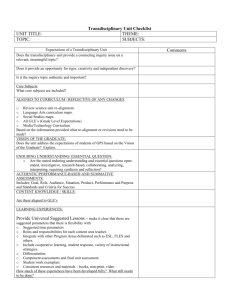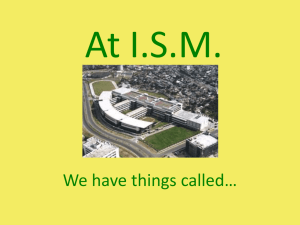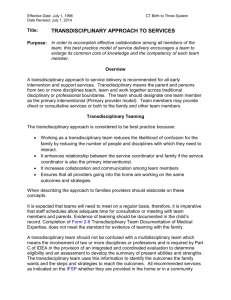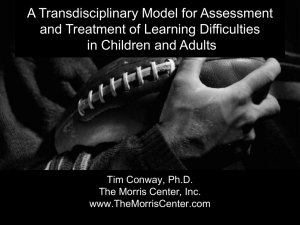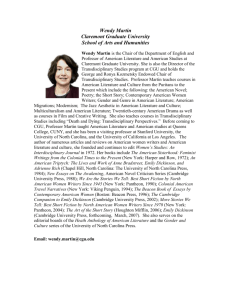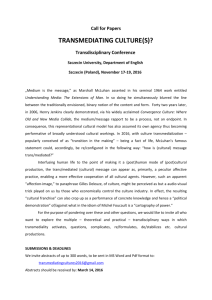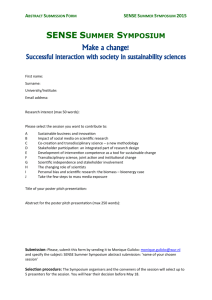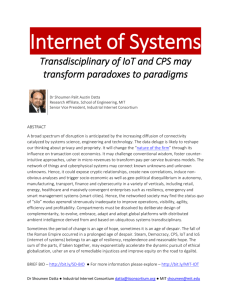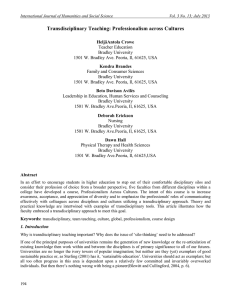Processes and Outcomes of Transdisciplinary Collaboration
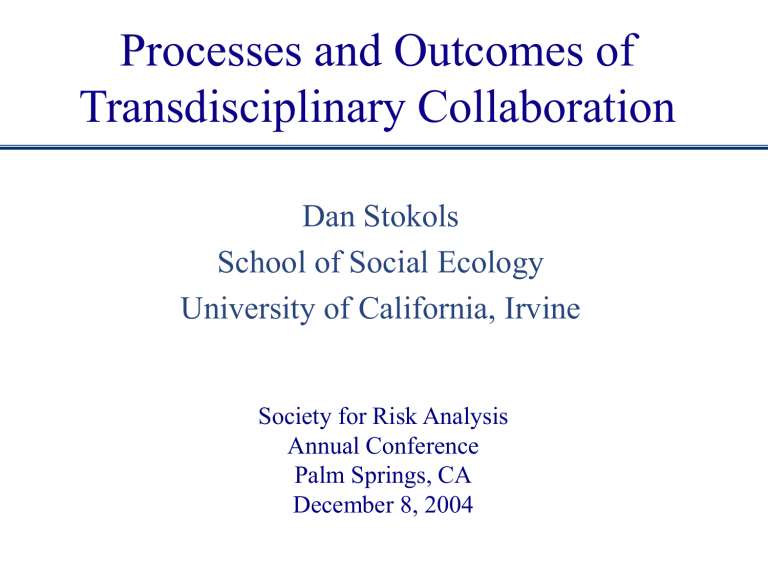
Processes and Outcomes of
Transdisciplinary Collaboration
Dan Stokols
School of Social Ecology
University of California, Irvine
Society for Risk Analysis
Annual Conference
Palm Springs, CA
December 8, 2004
Surge of Interest and Investment in
Transdisciplinary Collaboration
Over the Past Three Decades
Large-Scale Initiatives to Promote
Transdisciplinary Scientific Collaboration
•
MacArthur Foundation Networks in Mental Health and Human Development (1980s)
•
NCI TTURC, CECCR, TREK Programs (1999-)
•
Robert Wood Johnson Foundation Active Living
Program (2002-)
•
NIH Roadmap Initiative (2003-)
•
NAS/Keck Foundation Initiative to Transform
Interdisciplinary Research (2003-)
Transdisciplinary Collaboration…
in Principle and in Practice
Presumed Benefits of Transdisciplinary
Scientific Collaboration
• Greater Explanatory Power
• Methodological Pluralism
• Broad-Gauged Public Policies
• Advantages of Generalist Training Programs
Potential Costs of Transdisciplinary
Scientific Collaboration
• Labor Intensive and Conflict Prone
• Administratively Complex
• Analytic Breadth vs. Depth Tradeoffs
• Diffuse vs. Focused Conceptual Models
Key Question
By what criteria should the scientific and societal value of these large-scale investments in transdisciplinary research be judged?
Outcomes of Scientific Collaboration
• Novel Integrative Ideas
• Scientific Advances
• Training Outcomes
• Institutional Changes
• Public Policy Innovations
• Public Health Outcomes
Assessments of Collaborative Outcomes
• Processes and Products
• Univariate vs. Multivariate Criteria
• Center-Specific and Initiative-Wide
• Substantive vs. Transdisciplinarity Focus
Criteria for Evaluating Successful
Transdisciplinary Collaboration
Multiple “Windows” on processes of TD Collaboration:
•
Self-Reported Changes in TD Activities and Values
•
Semantic Differential Measures of Affective Experiences
•
Collaborative Relations Survey of Teamwork
• Archive of “Intellectual Capital” and Related Products
The Periodic Table of Elements
TD Terminology
• Disciplinary
• A-disciplinary/Non-disciplinary
• Multidisciplinary
• Interdisciplinary
• Transdisciplinary
• Inter-Professional
• Inter-Sectoral
• Inter-Perspective Inquiry
• Trans-Experiential
Some Dimensions of
Transdisciplinarity
•
Non-Collaborative / Collaborative
•
Geographically-Dispersed / Place-Based Teams
•
Scientific (conceptual) / Applied (instrumental)
•
University-Centric / Inter-sectoral
•
Sustainable / Non-Sustainable
•
Spontaneous / Routinized
Cross-Disciplinary Research
...
a process through which the perspectives of two or more scientific or professional fields are combined to achieve a more complete understanding of a particular phenomenon
Scientific Discipline
A field of research that focuses on distinctive substantive concerns (e.g., biological, psychological, social, physical environmental “facts”); and emphasizes particular analytic levels (e.g., molecular, organismic, interpersonal, organizational, societal), concepts, and methods
.
Disciplinary Foci
•
•
•
•
Biological Facts
Psychological Facts
Social Facts
Physical-Environmental Facts
Physical Environmental Fact
High Levels of Air and Water
Pollution in One’s Neighborhood
Social Fact
Environmental Racism
Biomedical Fact
Elevated Cancer Rates
Among Residents
.
Types of Cross-Disciplinary Science
multidisciplinary - researchers in different disciplines work independently or sequentially, each from his or her own disciplinary-specific perspective, to address a common problem
interdisciplinary - researchers work jointly , but from each of their respective disciplinary perspectives, to address a common problem
transdisciplinary - researchers work jointly using a shared conceptual framework that draws together discipline-specific theories, concepts, and approaches, to address a common problem
(Rosenfield, 1992)
Horizontal Integration of Disciplines
Crosses disciplines within one level or category of analysis and discourse
Vertical Integration of Disciplines
Links disciplines across analytic levels:
1. molecular/genetic/biological
2. psychological/developmental
3. social/organizational/institutional
4. societal/community policy levels
.
UCI TTURC Transdisciplinary
Core Research Team
Daniel Stokols, Ph.D.
Jennifer Gress
Richard Harvey
Kimari Phillips
Juliana Fuqua
Supported by NIH-TTURC
Award #DA-13332
QuickTime™ and a
Photo - JPEG decompressor are needed to see this picture.
TD Core Research Team
Transdisciplinary Core
Goals and Strategies
1.
Establish criteria for assessing Transdisciplinary
Scientific Collaboration (TDSC)
2. Model the antecedents, processes and outcomes of TDSC
3. Develop data-gathering tools for analyzing
TDSC
4. Develop a grounded theory of TDSC
Working Model of Transdisciplinary Scientific Collaboration
Antecedents Processes Outcomes
•Intrapersonal
•Social
•Physical Environmental
•Organizational
•Institutional
•Behavioral
•Affective
•Interpersonal
•Intellectual
•Novel Ideas
•Integrative Models
•New Training programs
•Institutional Changes
•Innovative Policies
Some Caveats…
• Few precedents for this type of research in the field of science studies
• Little prior agreement on the meaning and intended outcomes of transdisciplinary research
• Non-random selection of scientists into collaborative research ventures; small Ns
• Non-neutral status of evaluators, reactivity of measures
• Indeterminant timeframe for evaluation--5 year program evaluation vs. multi-decade historical perspective
What processes account for TD collaboration and are they experienced differently among TTURC members?
Multiple “Windows” on processes of TD Collaboration:
•
Self-Reported Changes in TD Activities and Values
•
Semantic Differential Measures of Affective Experiences
•
Collaborative Relations Survey of Teamwork
• Archive of “Intellectual Capital” and Related Products
Behavior Change Index (BCI)
The Behavior Change Index (BCI) assessed behaviors that indicate a willingness to participate in TDSC. Sample items included: a. Attended conferences or Read journals outside your field b. Readiness/willingness to collaborate with other TTURC investigators c. Obtained new insights into your own research through discussion with others d. Established links with your fellow TTURC colleagues that have led to or, may lead to future collaborative studies
Reported Increases in Transdisciplinary Behaviors
Among UCI TTURC Members
Participation in Working Groups Increased
Investigators’ Semantic Differential
Ratings of the TTURC Between Fall
2002-Fall 2003
Semantic Differential Scale (SDS)
SDS items assessed TTURC members’ affective impressions about the Center.
Sample anchor words included: a. Satisfying/ Frustrating b. Optimistic/ Pessimistic c. Socially Integrated/ Alienated d. Enjoyable/ Unenjoyable e. Appreciated/ Unappreciated
Cyclical Variation in Affect
Over Four Time Points
4.5
Change in Aggregate Mean of All Items
4.0
3.5
3.0
2.5
TIME
Fall '01 Spring '02 Fall '02 Spring '03
Neuroscientists’ and Behavioral
Scientists’ Semantic Differential
Ratings of the TTURC Between Fall
2002-Fall 2003
Worlds of Difference Among
Behavioral and Neuroscientists
Alternative “World Views” of Science
(See D’Andrade, Three scientific world views and the covering law model. In D. Fiske & R. Shweder (Eds.), Metatheory in social science.
Chicago: University of Chicago Press, 1986, 19-4)
Dissimilar Sociospatial Environments and Cultural Norms
Implications of Alternative
World Views
Centripetal Forces Toward Convergence within the UCI TTURC--for example, evolution of a shared conceptual model of tobacco addiction, use, and prevention
Centrifugal Forces Toward Divergence within TTURC centers, reflected in the reduced centrality of certain ideas and participants over time
Correspondence Analysis of the Degree to Which UCI TTURC
Investigators Work Closely With Each Other to Integrate Ideas
3.5
8
2.1
0.7
-0.7
1
4
6
3
2
9
5
-2.1
-3.5
-3.5
-2.1
-0.7
0.7
7
10
2.1
3.5
Mars
Venus
Assessment of Intellectual Themes
Intellectual Themes: assessed content of qualitative surveys and interviews. Sample items included: a. Have your collaboration efforts involved linking concepts or methods? b. What is the status of the collaborative integration?
c. Do you think this integration will lead to a tangible product? If so, what kind?
Charting The Intellectual History of a Research Organization
Evolution of Intellectual Themes
• Which ideas were present at the outset of the TTURC?
• Which ideas were dropped in subsequent years?
• Which new ideas emerged later in the project?
• Which initial ideas were modified over time?
• Which ideas were integrated with previously separate ideas?
Determinants of “ Collaboration Readiness”
Similarity of researchers’ scientific worldviews
Spatial, functional, and electronic proximity among investigators
Overlapping departmental identities of team members
History of collaboration on prior projects-preparation, practice, and trust
Members strongly committed to TD work
Director’s management experience and commitment
Formative evaluation processes to facilitate collaboration
Institutional support for TD collaboration
Alternative Pathways Toward
Transdisciplinary Collaboration
Low level of readiness for TDSC steps taken to reduce barriers to collaboration high levels of collaborative activity over the long-term
High level of readiness for TDSC high levels of collaborative activity over a relatively short timeframe
Translation of Findings into Guidelines for Improving Future Collaborations
• Continue to Expand Cumulative
Database on TD Collaborations
• Develop and Evaluate Educational
Strategies for Training Future TD
Scientists and Practitioners
• Tailor Collaborative Goals and
Arrangements to the Circumstances
Surrounding Particular Projects
